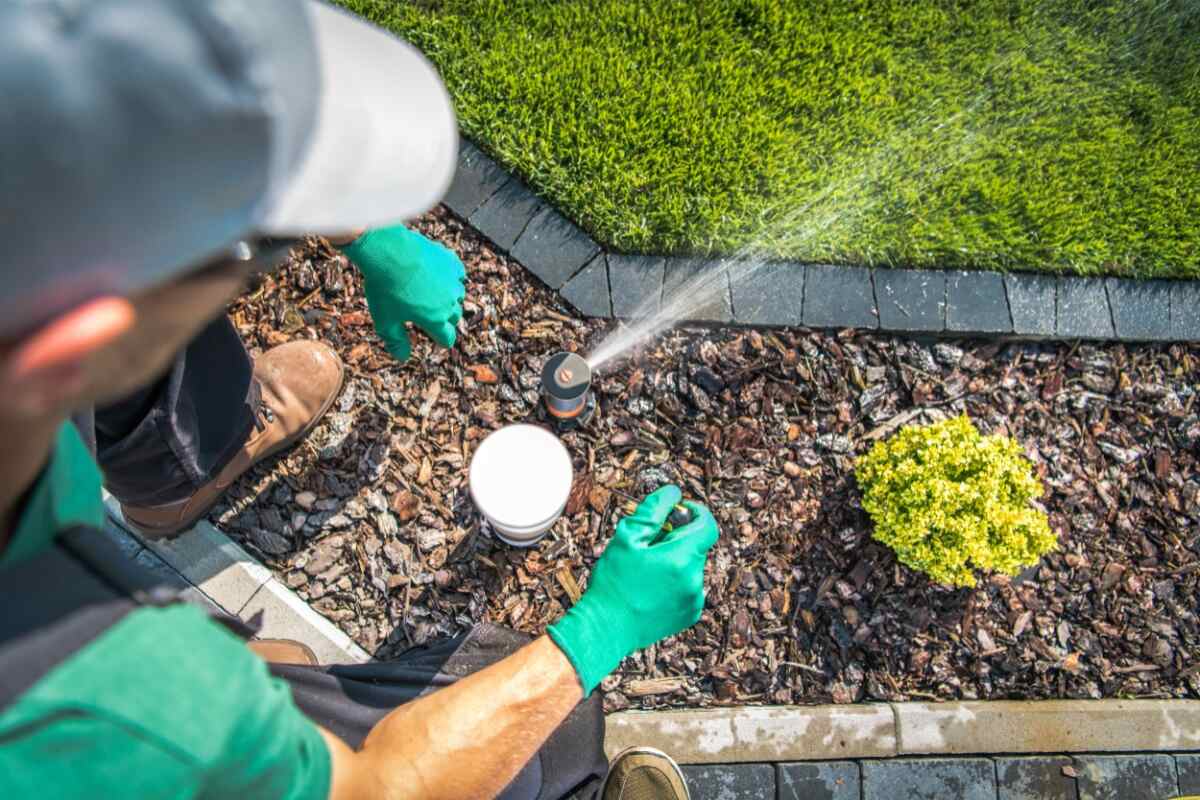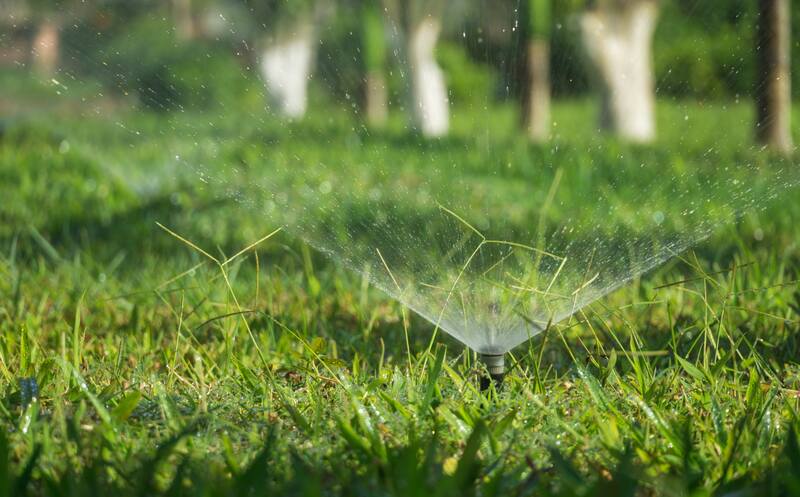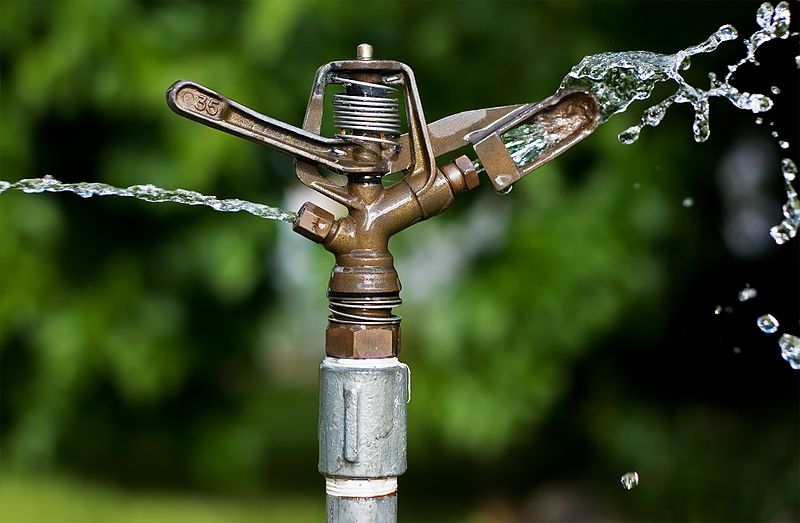
Lawn and garden sprinklers are designed to operate at different water pressure levels and with different spray patterns. The way a certain type of sprinkler works may make it more effective in a rectangular yard than an irregularly shaped space or better suited for a vegetable garden than turfgrass. This article covers the types of sprinklers available to help you choose the right one for your home’s specific needs.
6 Types of Sprinklers (Plus Drip Irrigation)
There are six different types of sprinklers typically used on lawns. Understanding how each operates and their advantages and disadvantages will help you decide which is best for your needs and if you need multiple types of sprinklers.
We’ll also cover drip irrigation, a more water-wise irrigation option than sprinklers, as a bonus. Drip irrigation is more suited to gardens and flower beds than lawns.

Stationary Lawn Sprinklers
Stationary sprinklers, also called fixed sprinklers, have a pole extending from a base. A sprinkler head is attached on top of the pole and stays in a fixed location, spraying water in a fixed pattern. Fixed sprinklers can spray in different patterns, such as circular or square.
Choose a stationary lawn sprinkler model with a hose connector containing a metal filter. The filter helps prevent clogging.
| Pros | Cons |
| ✓ Depending on the model, they are suitable for low water pressure. ✓ The height of the pole enables it to water over plants and any obstacles. ✓ Multiple spray patterns are available. ✓ Heads come in multiple models to fit onto different types of hoses. ✓ Low cost. ✓ Disburses a large amount of water rapidly. ✓ Great for small areas. ✓ No moving parts, so less likely to break. | ✗ Not the best option for large areas because they do not spray water far. ✗ May have to move it often to get consistent coverage. ✗ Spraying large amounts of water can lead to overwatering. |
Oscillating Sprinklers
Oscillating sprinklers are the old-school sprinkler attachments you could not resist running through when you were a child. They are comprised of a plastic or metal tube with multiple holes that disburse water in a paper-fan-like pattern – kind of like a bunch of fingers spread apart and waving. The tube moves back and forth. A higher-priced model will give you more spray pattern options.
| Pros | Cons |
| ✓ Typically is a good selection for use with high and low water pressure. ✓ Portable. ✓ Works well on rectangular areas. ✓ Depending on the model, can adjust the width and length to cover areas of different sizes (like front yard vs back yard and sides of the house). ✓ Children can entertain themselves and cool off during a hot summer day. ✓ Inexpensive. | ✗ The high spray is sometimes impacted by the wind. ✗ Some models have inconsistent water distribution. ✗ May require relocating to different areas of your lawn to water sufficiently. |
Rotary Sprinklers
Rotary sprinklers, also called rotating sprinklers, disburse water through two or more arms. The arms spin around a central base, spraying water as they turn in a complete circle.
| Pros | Cons |
| ✓ Suitable for large lawns. ✓ Provides even coverage. ✓ Water spray is more gentle than some other sprinklers. | ✗ The circular spray pattern may not wet all areas of square or rectangular yards. ✗ Changing the water flow is the only adjustment option. |
Impact Sprinklers
With impact sprinklers, strong water pressure helps move the sprinkler head in a circular or partial circular pattern, as it makes a clicking sound.
| Pros | Cons |
| ✓ A great option for large areas. ✓ The degree it rotates is adjustable (full circle or partial circle). ✓ You can control the height and distance of the water stream. ✓ The force of the water is adjustable. ✓ Less susceptible to the impact of the wind. | ✗ Very powerful streams of water can harm certain plants. (Make sure the diffuser pin is in place to soften the water flow to flower beds with delicate plants.) ✗ Does not perform well with low water pressure. ✗ Inconsistent coverage. ✗ Some models are difficult to adjust. |
Traveling Sprinklers
Traveling sprinklers move across your lawn on wheels. They look like small tractors. The water pressure moves the sprinkler system, and it uses your garden hose as a track for its path.
| Pros | Cons |
| ✓ Ideal for flat, large yards. ✓ Homeowners set the sprinkler’s path. ✓ Reduces the risk of overwatering. | ✗ Not ideal for small lawns. ✗ Requires monitoring to ensure it does not get stuck on inclines, debris, or other obstacles, like rocks and high grass. ✗ Should not be used on newly seeded lawns. ✗ Performs poorly with low water pressure. ✗ Can be costly. |
In-Ground Sprinkler Systems and Pop-Up Sprinklers
In-ground sprinkler systems are the best lawn sprinklers if you want a system that waters above ground and is hidden when it is not in use without having to put it away. The system consists of pipes buried underground and connected to a water supply. Sprinkler heads are inserted in the pipes. When the system is turned on, the heads pop up and disburse water onto your lawn and garden.
Pop-up sprinklers are the most common type of sprinkler in an in-ground sprinkler system. They rise from underground when activated and retract when the watering cycle is completed.
| Pros | Cons |
| ✓ Water evenly. ✓ Can be used for larger areas and small lawns. ✓ If different sprinkler heads have matching threadings, they are interchangeable. ✓ Retracting feature prevents it from being damaged by foot traffic, lawn mowers, and pets. ✓ Usually part of an automatic irrigation system, so it reduces lawn care tasks. | ✗ More costly than lawn sprinklers that connect to a hose. ✗ Sprinkler heads may require replacement more often than other sprinkler heads. ✗ Requires winterizing the sprinkler system and turning it back on in the spring. |
Drip Irrigation
A drip irrigation system isn’t really a type of sprinkler system, but it serves the same purpose. Drip irrigation is a type of low-pressure system made up of tubes with holes in them that deliver water directly to the roots of plants.
Because of how it works, drip irrigation is typically used for individual plants, such as trees, shrubs, flowers, fruits, and vegetables, rather than turfgrass. There are both pros and cons of drip irrigation, but it’s almost all pros for landscape and garden plants (not grass)!
| Pros | Cons |
| ✓ Conserves water. ✓ Prevents overwatering. ✓ Reduces water loss from evaporation. ✓ Helps prevent weeds. ✓ Great for xeriscapes and other water-wise landscaping. ✓ Easy and inexpensive to install DIY | ✗ Not ideal for lawn irrigation. ✗ Doesn’t work well with high water pressure. ✗ Tubes can become clogged easily. ✗ Usually requires more maintenance than traditional sprinklers. ✗ Heat and pests can damage the tubes. |
If you think drip irrigation might be the right choice for you, good news! Drip irrigation is typically pretty cheap and easy to install. Drip irrigation installation costs only about $490 on average.
How to Choose a Sprinkler for Your Home

Like any other product you purchase, a sprinkler system has pros and cons. Some are better suited for certain types of yards than others. Your home, needs, and preferences are unique. To make sure you select the right sprinkler for your yard, consider these factors:
Size of Your Yard: Some sprinklers are better for larger areas, while others only irrigate a small range. For example, a rotary sprinkler is best for a lawn larger than 30 square feet. However, a bubbler nozzle – also called a bubbler sprinkler head – only waters an area of about 5 feet or less.
Shape of Your Yard: The spray pattern of a sprinkler may make it more suitable for a circular-shaped property than for a property that is rectangular-shaped. Select the types of lawn sprinklers that will best cover your yard’s configuration or the shape of the area you wish to water.
Water Pressure: Some sprinklers require a certain amount of pressure to operate. Be familiar with your outdoor faucet’s water pressure so you can choose a compatible sprinkler head. If the manufacturer includes the sprinkler’s operating pressure on the packaging, it is typically measured in pounds per square inch (PSI).
Multiple Watering Needs and Hard-to-Reach Areas: Lawn sprinklers release water at different pressures and amounts, allowing homeowners to meet different plant watering needs. You may need to use multiple sprinkler systems. For example, a garden may require a gentler disbursement of water than your grass. Certain plant types may need more water or may not tolerate as much water as other plant types.
If you have areas that are difficult to reach, conventional sprinkler heads may not work at all. A drip irrigation system can help you water these regions. Drip irrigation delivers water slowly and allows you to target root systems and hard-to-reach areas. Fragile plants may benefit from drip irrigation. You can also combine a sprinkler system with a drip irrigation system.
Soil Type: Your soil type helps determine which sprinkler is best. For example, micro spray heads can deliver water at flow rates and patterns suitable for slow-absorbing soils. Rotor nozzles work well with slow-draining soils because these nozzles release water at a slower rate than spray nozzles.
Automatic or Manual: An automatic sprinkler system may cost a little more. But if you want the freedom of not having to turn a system on and keep track of when to turn it off, an automatic system will be worth it. Most automatic systems are in-ground sprinklers.
Once you know the best type of sprinkler for your home, you can plan and install your own sprinkler system DIY. Alternatively, you can hire a professional landscaper or irrigation company to install a sprinkler system for you. Professional sprinkler system installation costs about $0.60 per square foot of lawn.
Sprinkler Components

Sprinkler systems have different parts to get the job done. You may only think of the garden hose and the sprinkler head, but other components are needed for the system to operate. Here are some of the most important parts of a sprinkler system and what they all do.
Nozzles
Sprinkler heads have nozzles that disburse water in different spray patterns. Different nozzles spray water at different rates. Nozzles are included with systems and can be purchased separately.
Although some nozzles can be customized for your yard, many spray in one of three degrees of a circle: a quarter of a circle, a half circle, or a full circle. Some allow you to adjust the distance to which water is sprayed.
Riser
The nozzle sits on a vertical tube called a riser. The taller the riser, the greater the distance water can be disbursed. A riser can be fixed or be the moving component in an in-ground sprinkler system. Pop-up systems have risers that rise above ground when the system is activated.
The vertical pipe in an in-ground sprinkler system that connects the underground piping to the water supply is also called a riser.
Bubbler
A bubbler, also referred to as a flood sprinkler or bubbler nozzle, delivers a lot of water to a small area to flood it and soak the root zone. These spray heads are ideal for trees, planters, shrubs, and bushes. Water dissemination is fixed, or the flow rate can be set between ¼ gallon to 2 gallons per minute.
Rotor Nozzles
These nozzles rotate in a full or partial circle. They are designed to work at a water pressure of about 50 PSI. They release water in single or multiple streams. Rotor nozzles are like rotary nozzles, except rotary nozzles disburse water in multiple streams as they spin. Rotary nozzles also require less water pressure.
FAQ About Types of Sprinklers
Drip irrigation is comprised of hoses with holes and devices called emitters that drip water slowly. There are different types of drip irrigation systems and ways to configure a system to meet your needs. You can have a one-zoned system or a multi-zoned system for plants with different watering needs.
A sprinkler hose is a hose with holes drilled in. The holes are evenly spaced and on one side of the hose. It is typically a flatter version of a regular garden hose.
A sprinkler hose is different from drip irrigation because it doesn’t release water in slow drips or directly at the root zone of plants. Instead, water sprays up from the holes all along the hose and arcs over the grass, much like traditional sprinklers.
No. If you feel comfortable, you can winterize your in-ground sprinkler system as a DIY project. Be sure to winterize your sprinkler system at the right time and correctly. You can do it all yourself or hire a professional to handle some of the more complicated steps.
The cost to hire a professional to winterize your sprinkler system is usually between $60 and $120.
Final Thoughts
Whether you require a sprinkler that fans back and forth or your property needs a half-circle pattern, there is a sprinkler that will get the job done. You can even ditch traditional sprinklers and try drip irrigation for a more efficient and drought-friendly watering solution.
LawnStarter can connect you to landscaping pros in your area to help you decide which types of sprinklers are best for your home. They can also handle all of your landscaping needs, from lawn mowing to yard cleanups and gardening.
Main Photo Credit: welcomia / Canva Pro / License